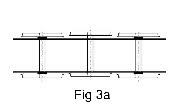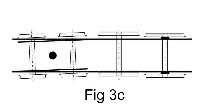


MORE ON DESIGN CONCEPTS
As well as flexibility in the vertical plane, locos need a little flexibility horizontally so that they can negotiate curves. I think there’s often a tendency to overdo this, especially with say 4-4-0’s, where all sorts of swing links are sometimes proposed. This may have been needed when negotiating a 15” Triang curve, but shouldn’t be necessary with finescale 00, EM or P4 layouts.
 Six wheel locos are straight forward -
Six wheel locos are straight forward - minimum side-play on the front and rear axles, and maximum sideplay on the centre axle. For a P4 chassis I use 15mm spacers (3’ 9” between the frames) which is a little underscale, but not noticeable. This allows sideplay on the centre axle of a little over 0.5mm which is sufficient for a B6 turnout.
 Eight-
Eight-wheel locos start to get a bit more complex. The LBSCR used many 0-6-2 and 4-4-0 types. The 0-6-2T’s all used radial axle boxes for the trailing wheels, and it is perfectly feasible to replicate this in model form. As with the 0-6-0, the front and rear driven axles need minimum sideplay, with about 0.5mm on the centre axle. The radial axle box deals with everything else. All of the 0-6-2’s that I have built are fully compensated, so that the radial axle box takes a proportion of the total loco weight, rather than being sprung or simply held on the track by its own weight. It is possible (although I think not really necessary) to centre-spring the radial box so that it functions like the prototype.
 Much has been written about 4-
Much has been written about 4-4-0 types - far too complicated in my humble view. As long as the track radius is not too severe, there is no reason why a simple pivot for the bogie should not suffice. There is a need to provide sideplay on the second driven axle, and as little as possible on the leading axle, but apart from that there shouldn’t be any need to provide a complex swing link mechanism. Using a simple pivot means that the bogie itself can be fully compensated, with the pivot acting as the third compensation point, with side-beams for the two driven axles providing the other two compensation points. As with the 0-6-2, full compensation means that the bogie can take a proportion of the loco weight.
As well as flexibility in the vertical plane, locos need a little flexibility horizontally so that they can negotiate curves. I think there’s often a tendency to overdo this, especially with say 4-
 Six wheel locos are straight forward -
Six wheel locos are straight forward - Eight-
Eight- Much has been written about 4-
Much has been written about 4-